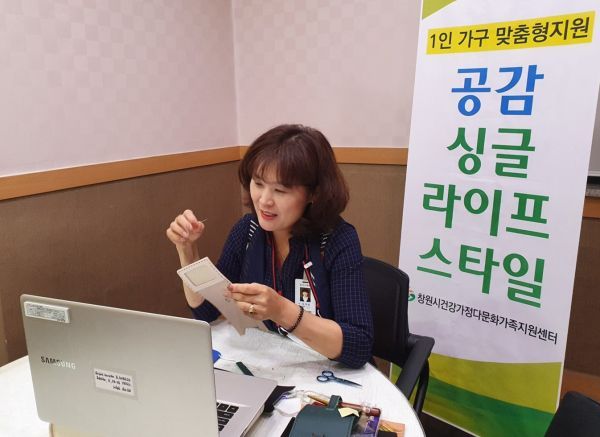 |
A civil servant from Changwon City Hall in South Gyeongsang Province offers information on tailor-made leisure activities to a group of citizens, residing alone, through an online meeting in September 2020. (Changwon City) |
SEJONG -- South Korea is heading toward a society in which the average household size is less than two, amid continuously falling marriage rates and an all-time low fertility rates.
According to the Ministry of Interior and Safety, the average population per household reached a record low of 2.23 -- 51.705 million people to 23.157 million households -- last month.
This is fewer by 0.06 people than 2.29, posted a year earlier in March 2020. The pace toward smaller families across the nation has become faster recently, given that the figure was 2.45 in March 2016 and 2.54 in March 2011.
Under the assumption that the shrinking speed would be the same at minus 0.06 per annum in the coming years, the number of people per household is set to fall below 2 within four years (1.99 in March 2025).
Ministry data indicates that this will happen sooner in Seoul and some provinces, which have relatively high proportions of single-person or two-member households.
Seoul’s population per household was 2.18 as of last month. This suggests that the figure is forecast to fall below 2 in only three years if the nationwide rate of decrease -- 0.06 people per year -- is applied. A decade earlier in March 2011, the capital’s figure reached 2.44.
The portion of single-person households has fast increased in the capital over the past decade -- from 36.3 percent of the total households in the region in March 2011 to 42.1 percent in March 2021.

Of the eight major cities and nine provinces, South Jeolla Province had the smallest average household size, with 2.06, followed by South Gyeongsang Province and Gangwon Province, both with 2.09.
The next on the list were North Jeolla Province and North Chungcheong Province (2.14), South Chungcheong Province (2.15), Busan (2.21), and Daejeon, Jeju Province and South Gyeongsang Province (2.23).
Among the 17 regions, the highest figure was recorded in Sejong, where the proportion of single-person households is relatively low. Many civil servants -- even those working in the administrative city or staying there on weekdays -- are registered as living in other regions such as Seoul, Gyeonggi Province and Daejeon.
In addition, Sejong is the only region whose residents’ average age is under 40. This means that the portion of pensioners living alone is lower than that of the other areas.
In contrast, regions such as South Jeolla Province and North Gyeongsang Province have significant numbers of elderly people who are living alone after losing spouses.
Next to Sejong, the figure exceeded the nationwide average in Ulsan at 2.36, Gyeonggi Province at 2.35, Incheon at 2.31, and Daegu and Gwangju, both at 2.27.
Data showed that the population per household is generally in inverse proportion to the average age in regions.
South Jeolla Province -- whose population per household is the lowest - was also the oldest province, with an average age of 47 as of March, followed by North Gyeongsang Province with 46.5, Gangwon Province with 46.1, North Jeolla Province with 45.8 and Busan with 45.2.
Sejong citizens were the youngest at 37.4 years old, while the next youngest group included those in Gyeonggi Province and Gwangju at 41.5, those in Ulsan at 41.8, those in Daejeon at 42.1, those in Jeju Province and Incheon at 42.5.
The nationwide average age was 43.3 (42.2 for men and 44.5 for women), which contrasted to 38.3 (37.1 and 39.5) in March 2011.
By Kim Yon-se (
kys@heraldcorp.com)






![[Exclusive] Hyundai Mobis eyes closer ties with BYD](http://res.heraldm.com/phpwas/restmb_idxmake.php?idx=644&simg=/content/image/2024/11/25/20241125050044_0.jpg)
![[Herald Review] 'Gangnam B-Side' combines social realism with masterful suspense, performance](http://res.heraldm.com/phpwas/restmb_idxmake.php?idx=644&simg=/content/image/2024/11/25/20241125050072_0.jpg)

